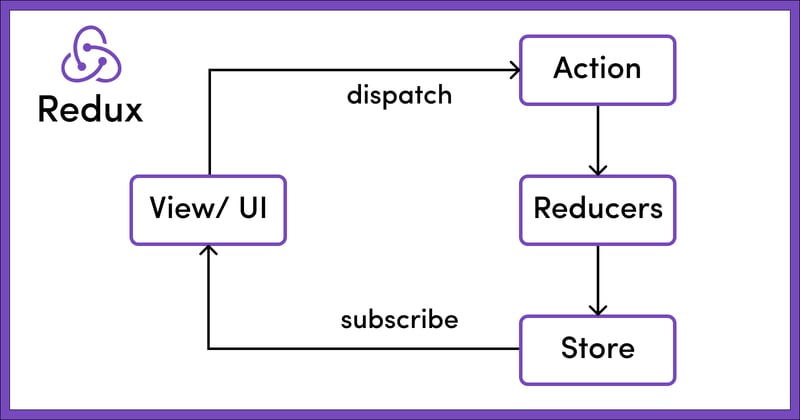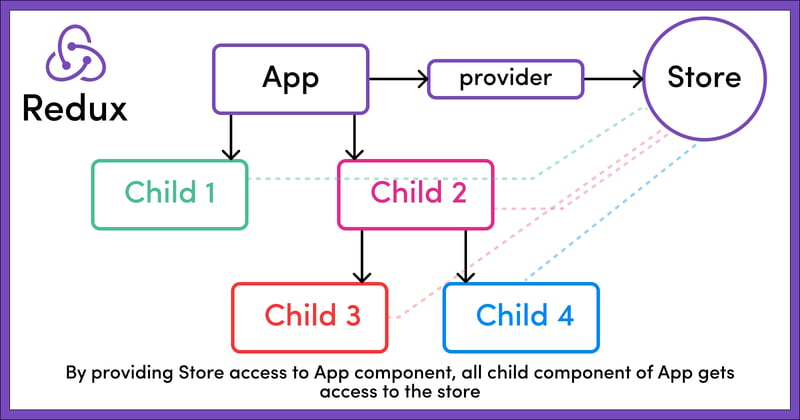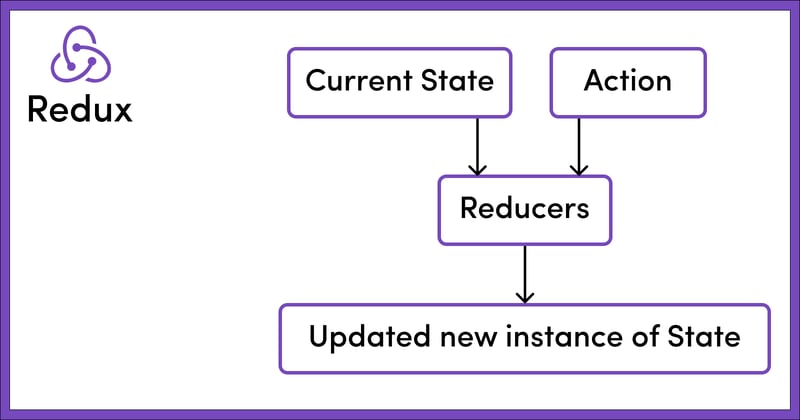ما هو Redux وكيف يمكننا استخدامه؟
What is Redux, and how do we use it? Redux is like a helpful tool for managing the state of JavaScript programs. It helps keep everything organized and makes it easier to work with. Think of it as a way to keep track of what's happening in your program and make sure everything stays stable.
Basically, Redux can work smoothly with different JavaScript libraries or frameworks like React, Angular, or Vue. It makes them even better at managing the stuff they do. That's why learning about Redux is super important for web developers.
In this article, we're going to talk about the basics of Redux. We'll explain what it is, why people use it, and how it works. We'll look at important parts like Store, Actions, and Reducers, which are the building blocks of Redux. Making learning and investing in Redux training highly important for web developers.
What is Redux and Why Use It?
One common question about Redux is why people use it. So, what's the reason? Well, Redux is really valuable for managing the state of applications, especially when they get more complex. Let's take the example of an e-commerce website with different parts like a shopping cart, user profile, etc.
Let's focus on the shopping cart part for a better understanding. It's responsible for showing the number of items in the user's cart. Its state includes all the items added and their total count. This information needs to be constantly updated and accurately displayed to the user.
When a user adds or removes items, the program needs to handle these actions internally, update the cart's state, and reflect changes in the user interface.
Initially, managing state within separate components works fine, but as the program grows more complex, sharing state between components for tasks like display, updates, or executing logic based on shared data becomes necessary. This is where Redux shines and provides the main answer to why Redux is used.
Redux acts as a centralized state management library, handling the program's state. It provides essential APIs for changing and accessing the current state and effectively simplifies the process of managing multiple states across different components.
What makes Redux predictable?
What distinguishes Redux in terms of predictability is its strict adherence to the principle of state immutability. In Redux, changing the state of the application requires dispatching a certain type of action that precisely specifies the desired changes. These actions are then processed by reducers, whose task is solely to handle the current state and action, producing a new and updated state instance. Reducers do not directly modify the state; instead, they create a new state instance that incorporates the necessary changes.
As stated by Redux creator Dan Abramov:
actions can be recorded and replayed later, ensuring consistent state management.
To illustrate this concept and to precisely understand what Redux is, let's consider an example from an online store. If the shopping cart initially holds 0 items, adding a product increases the item count to 1. Repeating this action further increases the item count, ensuring a predictable outcome.
By consistently producing the same final state based on the initial state and a specific sequence of actions, Redux guarantees predictability. In the next section, we'll delve deeper into the key components of Redux.
The core components of Redux are:

To better understand what Redux is and how it works, let's explore its key components. Essentially, Redux consists of the following three parts:
**1. Store
- Action
- Reducer**
What is the Store in Redux?
The Store in Redux acts as a centralized repository for the global state of the application, organized in a hierarchical tree structure. It's crucial to consider the Redux Store as the sole source for the application's state.
By integrating the Store into the main component (e.g., App.js) using the Provider component, all child components in the application gain access to the globally stored state within the Redux Store. This effectively creates a type of globally accessible state throughout the application. The following example illustrates this concept:
`// src/index.js
import React from 'react'
import ReactDOM from 'react-dom'
import { Provider } from 'react-redux' // Importing the Provider component from 'react-redux'
import { App } from './App' // Importing the main App component
import createStore from './createReduxStore' // Importing the function to create the Redux store
const store = createStore() // Creating the Redux store using the createStore function
// As of React 18
const root = ReactDOM.createRoot(document.getElementById('root')) // Creating a root element to render the React app
root.render(
// Wrapping the App component with the Provider component and passing the Redux store as a prop
)`

The above code snippet initializes the Redux Store using the createStore function and then integrates it into the React application by wrapping the main App component with the Provider component. As a result, the Redux Store becomes accessible to all components of the application.
The entire state of the application is structured as a kind of JavaScript object tree within the Redux Store. As illustrated below:
`// Example of the structure of the store object
{
noOfItemInCart: 2, // Represents the total number of items in the cart
cart: [ // Represents an array containing details of each item in the cart
{
bookName: "Harry Potter and the Chamber of Secrets", // Name of the book
noOfItem: 1, // Quantity of this book in the cart
},
{
bookName: "Harry Potter and the Prisoner of Azkaban", // Name of another book
noOfItem: 1 // Quantity of this book in the cart
}
]
}`
}`
In the above example, the Redux Store has two main features:
noOfItemInCart
: Indicates the total number of items in the cart.
cart
: An array containing objects, each representing a specific item in the cart. Each object includes properties such as bookName, which represents the name of the book, and noOfItem, which indicates the quantity of that book in the cart.
What is an action in Redux?
Actions in Redux are essential for changing the application's state. They are JavaScript objects that describe what has happened in the application. As mentioned earlier, Redux enforces the idea of immutable state and prevents direct changes through views or network calls. Instead, any state changes must be communicated through actions.
Let's consider a scenario with a sample store containing two books, each with one copy. Now, imagine a user wants to add another item to their cart. They click on the "Add to Cart" button next to the desired item.
Upon clicking, a type of action is dispatched. This action, represented as a JavaScript object, reflects the necessary changes in the store. The following example illustrates this concept:
`const dispatch = useDispatch();
const addItemToCart = () => {
return {
type: "ADD_ITEM_TO_CART",
payload: {
bookName: "Harry Potter and the Goblet of Fire",
noOfItem: 1,
}
};
};
`
`const dispatch = useDispatch();
const addItemToCart = () => {
return {
type: "ADD_ITEM_TO_CART",
payload: {
bookName: "Harry Potter and the Goblet of Fire",
noOfItem: 1,
}
};
};
`
In the above example, the addItemToCart function acts as an action creator. When called, it generates an action object that describes the intention to add a specific book to the cart. This action includes a type property indicating the type of action ("ADD_ITEM_TO_CART") and a payload containing the details of the book to be added.
This structured approach ensures transparency and consistency in state management, facilitating effective communication of state changes throughout the application.
For a better understanding of actions in Redux:
To better understand what actions are and what role they play in Redux, let's slightly complicate the previous example. In Redux, each action must have a type property that specifies the type of dispatched operation. While additional details can be included in the action object, they are optional and vary depending on the specific action being dispatched. For example, consider the action created by addItemToCart in the previous example:
`const dispatch = useDispatch();
const addItemToCart = () => {
return {
type: "ADD_ITEM_TO_CART",
payload: {
bookName: "Harry Potter and the Goblet of Fire",
noOfItem: 1,
}
};
};
`
`// Action created by the addItemToCart action creator
{
type: "ADD_ITEM_TO_CART", // Note: Every action must have a type key
payload: {
bookName: "Harry Potter and the Goblet of Fire",
noOfItem: 1,
}
}`
In the above example, the action type or action ADD_ITEM_TO_CART indicates the intention to add items to the cart. Additionally, the payload property contains specific details about the added item, such as its name and other relevant details.
What are Reducers in Reducers?

This uniform structure in managing actions ensures consistency and allows reducers to accurately interpret and process the dispatched actions. As a result, it facilitates effective state management in Redux.
Reducers in Redux are another essential part, but what exactly are reducers and what do they do? Reducers are essentially functions responsible for changing the application state based on dispatched actions. They adhere to the principle of immutability, meaning they don't directly alter the current state; instead, they return a new updated state.
In essence, reducers receive two parameters: the previous state and an action. They then process this information to indicate a new state representing the current state of the application.
In larger applications, there may be multiple reducers, each managing different parts or sections of the global state. For example, one reducer might manage the shopping cart state, while another handles user details.
When an action is dispatched, all reducers are called. Each reducer examines the action using a switch statement to identify its type. Upon finding a match, the corresponding reducer performs necessary updates to the state and returns a new instance of the global state.
For a better understanding of reducers in Redux:
To better grasp what reducers are and their role in Redux, let's consider the following example:
`const dispatch = useDispatch();
const addItemToCart = () => {
return {
type: "ADD_ITEM_TO_CART",
payload: {
bookName: "Harry Potter and the Goblet of Fire",
noOfItem: 1,
}
};
};
`
`const initialCartState = {
noOfItemInCart: 0,
cart: []
}
// NOTE:
// It is important to pass an initial state as default to
// the state parameter to handle the case of calling
// the reducers for the first time when the
// state might be undefined
const cartReducer = (state = initialCartState, action) => {
switch (action.type) {
case "ADD_ITEM_TO_CART":
return {
...state,
noOfItemInCart: state.noOfItemInCart 1,
cart : [
...state.cart,
action.payload
]
}
case "DELETE_ITEM_FROM_CART":
return {
// Remaining logic
}
default:
return state
} // Important to handle the default behaviour
} // either by returning the whole state as it is
// or by performing any required logic`
In the above example, we created a reducer called cartReducer, which is a JavaScript function. This function accepts two parameters.
The state parameter has a default value, initialCartState, so that the reducer can handle scenarios where it is called for the first time with an undefined state. Each reducer must handle the default state, where if no action types match, it returns the current state. This ensures that the state remains unchanged in case of dispatching unrelated actions.
When an action is dispatched, the appropriate reducer is called based on the action type. In our example, when the "Add to Cart" button is clicked, the action creator addItemToCart dispatches an action of type ADD_ITEM_TO_CART.
Then, cartReducer processes this action by matching its type. If it matches ADD_ITEM_TO_CART, it updates the state by incrementing the noOfItemInCart value and adding a new item to the cart array accordingly.
It's important to note that Redux enforces immutability, so reducers create a new copy of the state with the necessary changes instead of directly modifying the existing state.
After updating the state by the reducer, the changes reflect. For example, after adding a new item to the cart, the updated state includes the incremented value of noOfItemInCart and the newly added item in the cart array. This structured approach ensures predictable state updates and maintains consistency in managing state in Redux applications.

Learning Redux and its importance
Redux is guided by three key principles:
- Centralized State Management: The entire application state is stored in a single, centralized store, organized in a unique tree-like structure.
- Action-Driven State Updates: State changes are initiated by dispatching actions, which are objects describing what happened in the application.
- State Transformation via Reducers: Reducers dictate how the state tree reacts to actions, ensuring predictable updates and maintaining state consistency.
-
 مبدأ عمل Python metaclass وإنشاء فئة وتخصيصهاما هي metaclasses في python؟ مثلما تنشئ الفصول مثيلات ، تنشئ metaclasses دروسًا. أنها توفر طبقة من التحكم في عملية إنشاء الفصل ، مما يسمح بتخصيص...برمجة نشر في 2025-04-21
مبدأ عمل Python metaclass وإنشاء فئة وتخصيصهاما هي metaclasses في python؟ مثلما تنشئ الفصول مثيلات ، تنشئ metaclasses دروسًا. أنها توفر طبقة من التحكم في عملية إنشاء الفصل ، مما يسمح بتخصيص...برمجة نشر في 2025-04-21 -
 eval () مقابل AST.LITERAL_EVAL (): أي وظيفة Python أكثر أمانًا لإدخال المستخدم؟وزن eval () و ast.literal_eval () في Python Security غالبًا ما تنشأ eval () ، وهي وظيفة python قوية ، كحل محتمل ، ولكن المخاوف تحيط بمخاطرها ال...برمجة نشر في 2025-04-21
eval () مقابل AST.LITERAL_EVAL (): أي وظيفة Python أكثر أمانًا لإدخال المستخدم؟وزن eval () و ast.literal_eval () في Python Security غالبًا ما تنشأ eval () ، وهي وظيفة python قوية ، كحل محتمل ، ولكن المخاوف تحيط بمخاطرها ال...برمجة نشر في 2025-04-21 -
 Python قراءة ملف CSV UnicodedEcodeerror الحل النهائيلا يمكن فك تشفير البايت في الموضع 2-3: مقطوع \ uxxxxxxxxx escart string قم بتعبئة المسار إلى ملف CSV مع وضع صغير "r" للدلالة على سل...برمجة نشر في 2025-04-21
Python قراءة ملف CSV UnicodedEcodeerror الحل النهائيلا يمكن فك تشفير البايت في الموضع 2-3: مقطوع \ uxxxxxxxxx escart string قم بتعبئة المسار إلى ملف CSV مع وضع صغير "r" للدلالة على سل...برمجة نشر في 2025-04-21 -
 حل الاستثناء \\ "خطأ قيمة السلسلة \\" عند إدراج MySQL Emoji'\ xf0 \ x9f \ x91 \ xbd \ xf0 \ x9f ...' ينشأ هذا الخطأ لأن حرف UTF8 الافتراضي الخاص بـ MySQL يدعم فقط الأحرف داخل المستوى متعدد اللغات....برمجة نشر في 2025-04-21
حل الاستثناء \\ "خطأ قيمة السلسلة \\" عند إدراج MySQL Emoji'\ xf0 \ x9f \ x91 \ xbd \ xf0 \ x9f ...' ينشأ هذا الخطأ لأن حرف UTF8 الافتراضي الخاص بـ MySQL يدعم فقط الأحرف داخل المستوى متعدد اللغات....برمجة نشر في 2025-04-21 -
 لماذا لا يعرض Firefox صورًا باستخدام خاصية CSS `content`؟يمكن ملاحظة ذلك في فئة CSS المقدمة: . Googlepic { المحتوى: url ('../../ img/googleplusicon.png') ؛ الهامش: -6.5 ٪ ؛ حشو اليمين...برمجة نشر في 2025-04-21
لماذا لا يعرض Firefox صورًا باستخدام خاصية CSS `content`؟يمكن ملاحظة ذلك في فئة CSS المقدمة: . Googlepic { المحتوى: url ('../../ img/googleplusicon.png') ؛ الهامش: -6.5 ٪ ؛ حشو اليمين...برمجة نشر في 2025-04-21 -
 تنفيذ طريقة مائلة للنص المحاذاة اليساري في جميع المتصفحات] ] محاذاة النص على الخطوط المائلة الخلفية يمكن أن يحقق النص المحاذاة اليسرى على خط مائل تحديًا ، بشكل خاص عندما يكون Secreta. التوافق (العودة إل...برمجة نشر في 2025-04-21
تنفيذ طريقة مائلة للنص المحاذاة اليساري في جميع المتصفحات] ] محاذاة النص على الخطوط المائلة الخلفية يمكن أن يحقق النص المحاذاة اليسرى على خط مائل تحديًا ، بشكل خاص عندما يكون Secreta. التوافق (العودة إل...برمجة نشر في 2025-04-21 -
 نصائح لالتقاط الصور العائمة على الجانب الأيمن من القاع واللف حول النصيمكن أن يخلق ذلك تأثيرًا مرئيًا جذابًا مع عرض الصورة بشكل فعال. ضمن هذه الحاوية ، أضف محتوى النص وعنصر IMG للصورة. يمكن أن يبدو رمز HTML مثل هذا: ...برمجة نشر في 2025-04-21
نصائح لالتقاط الصور العائمة على الجانب الأيمن من القاع واللف حول النصيمكن أن يخلق ذلك تأثيرًا مرئيًا جذابًا مع عرض الصورة بشكل فعال. ضمن هذه الحاوية ، أضف محتوى النص وعنصر IMG للصورة. يمكن أن يبدو رمز HTML مثل هذا: ...برمجة نشر في 2025-04-21 -
 أسباب وحلول لفشل الكشف عن الوجه: خطأ -215في الوظيفة detectmultiscale. " عادةً ما ينشأ هذا الخطأ عندما يتم تحميل مصنف Cascade للوجه ، وهو مكون حاسم للكشف عن الوجه ، بشكل صحيح. في مقتط...برمجة نشر في 2025-04-21
أسباب وحلول لفشل الكشف عن الوجه: خطأ -215في الوظيفة detectmultiscale. " عادةً ما ينشأ هذا الخطأ عندما يتم تحميل مصنف Cascade للوجه ، وهو مكون حاسم للكشف عن الوجه ، بشكل صحيح. في مقتط...برمجة نشر في 2025-04-21 -
 الحصول على أقصى قيمة وطرق البيانات المقابلة بكفاءة من جداول قاعدة بيانات SQL الكبيرةبكفاءة في العثور على أقصى قدر من القيم والبيانات المرتبطة بها في جداول SQL الكبيرة في كثير من الأحيان ، تتطلب استعلامات قاعدة البيانات إيجاد ا...برمجة نشر في 2025-04-21
الحصول على أقصى قيمة وطرق البيانات المقابلة بكفاءة من جداول قاعدة بيانات SQL الكبيرةبكفاءة في العثور على أقصى قدر من القيم والبيانات المرتبطة بها في جداول SQL الكبيرة في كثير من الأحيان ، تتطلب استعلامات قاعدة البيانات إيجاد ا...برمجة نشر في 2025-04-21 -
 كيفية الحصول على الخط الفعلي المقدم في JavaScript عندما تكون سمة خط CSS غير محددة؟الوصول إلى الخط الفعلي الذي تم تقديمه عندما يكون غير محدد في css ومع ذلك ، هذا لا يعني أن العنصر يتم تقديمه بدون خط. يطبق المتصفح عادةً أنماطًا...برمجة نشر في 2025-04-21
كيفية الحصول على الخط الفعلي المقدم في JavaScript عندما تكون سمة خط CSS غير محددة؟الوصول إلى الخط الفعلي الذي تم تقديمه عندما يكون غير محدد في css ومع ذلك ، هذا لا يعني أن العنصر يتم تقديمه بدون خط. يطبق المتصفح عادةً أنماطًا...برمجة نشر في 2025-04-21 -
 لماذا لا يوجد طلب آخر لالتقاط المدخلات في PHP على الرغم من الرمز الصحيح؟معالجة عطل طلب النشر في php $ _server ['php_self'] ؛؟> "method =" post "> ومع ذلك ، يظل الناتج فارغًا. على الرغم من ...برمجة نشر في 2025-04-21
لماذا لا يوجد طلب آخر لالتقاط المدخلات في PHP على الرغم من الرمز الصحيح؟معالجة عطل طلب النشر في php $ _server ['php_self'] ؛؟> "method =" post "> ومع ذلك ، يظل الناتج فارغًا. على الرغم من ...برمجة نشر في 2025-04-21 -
 كيفية إضافة محاور وعلامات إلى ملفات PNG في Java؟بدلاً من محاولة التعديلات التي يمكن أن تؤدي إلى أخطاء وتناقضات ، يوصى بدمج التعليقات التوضيحية أثناء عملية إنشاء المخطط. يوضح المثال التالي كيفية...برمجة نشر في 2025-04-21
كيفية إضافة محاور وعلامات إلى ملفات PNG في Java؟بدلاً من محاولة التعديلات التي يمكن أن تؤدي إلى أخطاء وتناقضات ، يوصى بدمج التعليقات التوضيحية أثناء عملية إنشاء المخطط. يوضح المثال التالي كيفية...برمجة نشر في 2025-04-21 -
 كيفية حل الخطأ "لا يمكن تخمين نوع الملف ، واستخدام التطبيق/ثنائي الثماني ..." في AppEngine؟التطبيق/actet-stream ... " دقة مشكلة لتصحيح هذه المشكلة وتحديد نوع mime الصحيح للملفات الثابتة ، اتبع الخطوات هذه: /etc/mime.types file...برمجة نشر في 2025-04-21
كيفية حل الخطأ "لا يمكن تخمين نوع الملف ، واستخدام التطبيق/ثنائي الثماني ..." في AppEngine؟التطبيق/actet-stream ... " دقة مشكلة لتصحيح هذه المشكلة وتحديد نوع mime الصحيح للملفات الثابتة ، اتبع الخطوات هذه: /etc/mime.types file...برمجة نشر في 2025-04-21 -
 لماذا تعتبر مقارنات "Flake8" المليئة بالملل في بنود مرشح Sqlalchemy؟flake8 مقارنة بين المقارنة المنطقية في جملة الفلتر عند محاولة مرشح نتائج الاستعلام بناءً على مقارنة منطقية في SQL ، قد يواجه المطورون تحضيرًا ...برمجة نشر في 2025-04-21
لماذا تعتبر مقارنات "Flake8" المليئة بالملل في بنود مرشح Sqlalchemy؟flake8 مقارنة بين المقارنة المنطقية في جملة الفلتر عند محاولة مرشح نتائج الاستعلام بناءً على مقارنة منطقية في SQL ، قد يواجه المطورون تحضيرًا ...برمجة نشر في 2025-04-21 -
 Async void vs. Async Task in ASP.NET: لماذا ترمي طريقة الفراغ Async أحيانًا استثناءات؟ومع ذلك ، يمكن أن يؤدي سوء فهم الاختلافات الرئيسية بين أساليب المهمة ASYNC و ASYNC إلى أخطاء غير متوقعة. يستكشف هذا السؤال لماذا قد تؤدي أساليب الف...برمجة نشر في 2025-04-21
Async void vs. Async Task in ASP.NET: لماذا ترمي طريقة الفراغ Async أحيانًا استثناءات؟ومع ذلك ، يمكن أن يؤدي سوء فهم الاختلافات الرئيسية بين أساليب المهمة ASYNC و ASYNC إلى أخطاء غير متوقعة. يستكشف هذا السؤال لماذا قد تؤدي أساليب الف...برمجة نشر في 2025-04-21
دراسة اللغة الصينية
- 1 كيف تقول "المشي" باللغة الصينية؟ 走路 نطق الصينية، 走路 تعلم اللغة الصينية
- 2 كيف تقول "استقل طائرة" بالصينية؟ 坐飞机 نطق الصينية، 坐飞机 تعلم اللغة الصينية
- 3 كيف تقول "استقل القطار" بالصينية؟ 坐火车 نطق الصينية، 坐火车 تعلم اللغة الصينية
- 4 كيف تقول "استقل الحافلة" باللغة الصينية؟ 坐车 نطق الصينية، 坐车 تعلم اللغة الصينية
- 5 كيف أقول القيادة باللغة الصينية؟ 开车 نطق الصينية، 开车 تعلم اللغة الصينية
- 6 كيف تقول السباحة باللغة الصينية؟ 游泳 نطق الصينية، 游泳 تعلم اللغة الصينية
- 7 كيف يمكنك أن تقول ركوب الدراجة باللغة الصينية؟ 骑自行车 نطق الصينية، 骑自行车 تعلم اللغة الصينية
- 8 كيف تقول مرحبا باللغة الصينية؟ # نطق اللغة الصينية، # تعلّم اللغة الصينية
- 9 كيف تقول شكرا باللغة الصينية؟ # نطق اللغة الصينية، # تعلّم اللغة الصينية
- 10 How to say goodbye in Chinese? 再见Chinese pronunciation, 再见Chinese learning

























